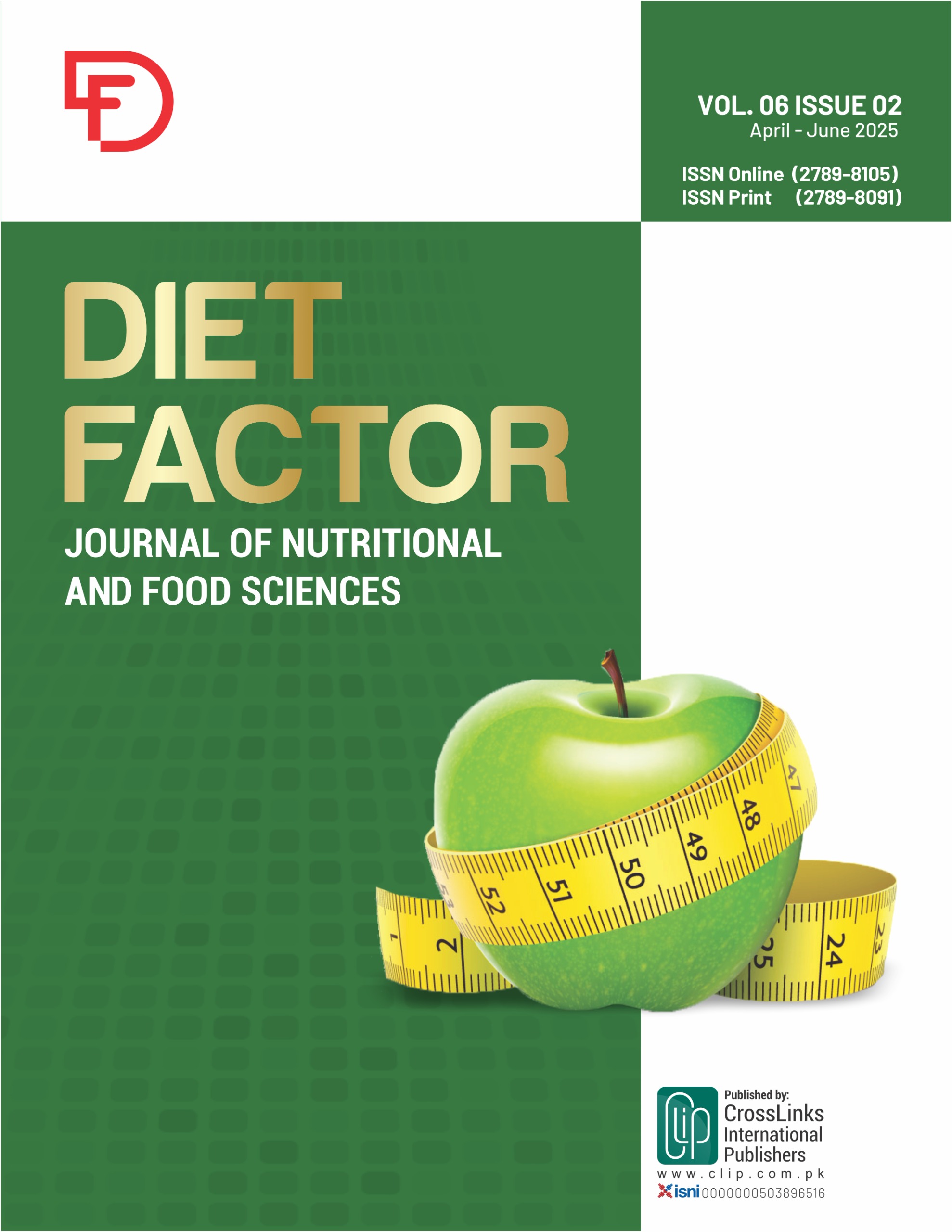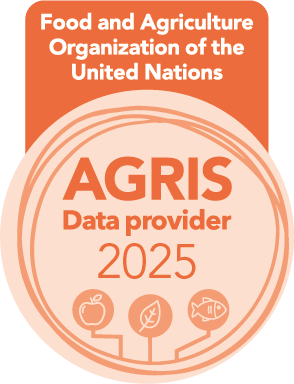Low Calcium Intake of Pre-Adolescent Girls from Customary Diets in A Semi-Rural Setting in Khyber Pakhtunkhwa, Pakistan
Low Calcium Intake of Pre-Adolescent Girls from Customary Diets
DOI:
https://doi.org/10.54393/df.v6i2.168Keywords:
Pre-Adolescents, Calcium, Barriers, Food Preferences, Calcium-Rich FoodsAbstract
Calcium is a critical nutrient for adolescent bone development and overall health, yet intake often remains below recommended levels in many populations. Objectives: To assess the calcium intake of pre-adolescent girls, their calcium fortified preferences, and perceived barriers to calcium-rich foods to inform targeted nutritional interventions. To assess the calcium intake of adolescent girls, their calcium fortified preferences, and perceived barriers to calcium-rich foods. Methods: A descriptive cross-sectional study was conducted, where 78 school girls aged 9-14 years completed FFQ with a focus on foods rich in calcium. The questionnaire also contained questions inquiring about the perceived barriers which could result in low intake/no intake of calcium-dense foods. Results: A total of 174 calcium-rich foods and products were available in Charsadda city. Mean intake of calcium (275 ± 52) was well below the RDI. Notable gaps in students' awareness of calcium sources and their importance existed. The top 8 Key barriers that potentially hinder the intake of nutritious foods were identified, including cost, low availability in the school environment, low awareness, inappropriate storage facilities at school, food habits, low nutrition education, food stigma, and junk food pressure. The data highlights a clear preference among students for certain calcium-fortified food types over others. Conclusions: Mean calcium intake from foods available to pre-adolescent girls was low, with numerous barriers identified that hinder calcium intake in this age group. Further, pre-adolescent girls preferred a variety of calcium-fortified foods, biscuits and milk on top of the list.
References
Santosa WN. Effect of Calcium Fortification On Health. Jurnal Wiyata: Penelitian Sains dan Kesehatan. 2024 Jun; 11(1): 13-8. doi: 10.56710/wiyata.v11i1.624.
Webster J, Dalla Via J, Langley C, Smith C, Sale C, Sim M. Nutritional Strategies to Optimize Musculoskeletal Health for Fall and Fracture Prevention: Looking Beyond Calcium, Vitamin D and Protein. Bone Reports. 2023 Dec; 19: 101684. doi: 10.1016/j.bonr.2023.101684.
Minkowitz B and Spingarn CM. Effective Counseling for Children's Bone Health. Journal of the Pediatric Orthopaedic Society of North America. 2024 May; 7: 100032. doi: 10.1016/j.jposna.2024.100032.
Shlisky J, Mandlik R, Askari S, Abrams S, Belizan JM, Bourassa MW et al. Calcium Deficiency Worldwide: Prevalence of Inadequate Intakes and Associated Health Outcomes. Annals of the New York Academy of Sciences. 2022 Jun; 1512(1): 10-28. doi: 10.1111/nyas.14758.
Sanwalka NJ, Khadilkar AV, Mughal M, Sayyad MG, Khadilkar VV, Shirole SC et al. A Study of Calcium Intake and Sources of Calcium in Adolescent Boys and Girls from Two Socioeconomic Strata, in Pune, India. Asia Pacific Journal of Clinical Nutrition. 2010 Sep; 19(3): 324-9.
Gómez G, Monge-Rojas R, Vargas-Quesada R, Previdelli AN, Quesada D, Kovalskys I et al. Exploring the FAO Minimum Dietary Diversity Indicator as a Suitable Proxy of Micronutrient Adequacy in Men and Women Across Reproductive and Non-Reproductive Ages in 8 Latin American Countries. Food and Nutrition Bulletin. 2024 Sep; 45(2_suppl): S55-65. doi: 10.1177/03795721241242920.
Palacios C, Hofmeyr GJ, Cormick G, Garcia‐Casal MN, Peña‐Rosas JP, Betrán AP. Current Calcium Fortification Experiences: A Review. Annals of the New York Academy of Sciences. 2021 Jan; 1484(1): 55-73. doi: 10.1111/nyas.14481.
Nguyen B and Murimi MW. Lack of Calcium Rich Foods in the Diet, Low Knowledge on Calcium Level Recommendations and Severe Food Insecurity Predicts Low Calcium Intake Among Vietnamese Women. Appetite. 2021 Aug; 163: 105242. doi: 10.1016/j.appet.2021.105242.
Bourassa MW, Abrams SA, Belizán JM, Boy E, Cormick G, Quijano CD et al. Interventions to Improve Calcium Intake Through Foods in Populations with Low Intake. Annals of the New York Academy of Sciences. 2022 May; 1511(1): 40-58. doi: 10.1111/nyas.14743.
Cormick G and Belizán JM. Calcium Intake and Health. Nutrients. 2019 Jul; 11(7): 1606. doi: 10.3390/nu11071606.
Pourhoseingholi MA, Vahedi M, Rahimzadeh M. Sample Size Calculation in Medical Studies. Gastroenterology and Hepatology from Bed to Bench. 2013; 6(1): 14.
Shah S, Al Ktebi A, Alam I. Knowledge About Calcium-Rich Foods in Adolescent Girls in Charsadda–A Cross-Sectional Study: Knowledge About Calcium-Rich Foods in Adolescent Girls. Diet Factor (Journal of Nutritional and Food Sciences). 2024 Dec: 25-30. doi: 10.54393/df.v5i04.167.
Payán DD, Sloane DC, Illum J, Farris T, Lewis LB. Perceived Barriers and Facilitators to Healthy Eating and School Lunch Meals among Adolescents: A Qualitative Study. American Journal of Health Behavior. 2017 Sep; 41(5): 661-9. doi: 10.5993/AJHB.41.5.15.
Louey J, He J, Partridge SR, Allman‐Farinelli M. Facilitators and Barriers to Healthful Eating among Adolescents in High‐Income Countries: A Mixed‐Methods Systematic Review. Obesity Reviews. 2024 Nov; 25(11): e13813. doi: 10.1111/obr.13813.
Beck AL, Iturralde E, Haya-Fisher J, Kim S, Keeton V, Fernandez A. Barriers and Facilitators to Healthy Eating among Low-Income Latino Adolescents. Appetite. 2019 Jul; 138: 215-22. doi: 10.1016/j.appet.2019.04.004.
Bel-Serrat S, von der Schulenburg A, Marques-Previ M, Mullee A, Murrin CM. What Are the Determinants of Vegetable Intake among Adolescents from Socioeconomically Disadvantaged Urban Areas? A Systematic Review of Qualitative Studies. International Journal of Behavioural Nutrition and Physical Activity. 2022 Dec6; 19(1): 158. doi: 10.1186/s12966-022-01396-9.
Bobridge K and O’Sullivan T. Pre-Adolescent and Adolescent (13–18 Years). In Food and Nutrition Throughout Life. 2020 Jul: 177-196. doi: 10.4324/9781003115670-11.
Mead SJ. Dietary calcium intakes and major contributing food sources of adolescent males in New Zealand (Doctoral dissertation, University of Otago). 2021.
Shah R. What About My Calcium? A Complete Plant-Based Guide for Calcium Health. Notion Press. 2024 Jun.
Chee WS, Chang CY, Arasu K, Wong SY, Ong SH, Yang WY et al. Vitamin D Status Is Associated with Modifiable Lifestyle Factors in Pre-Adolescent Children Living in Urban Kuala Lumpur, Malaysia. Nutrients. 2021 Jun; 13(7): 2175. doi: 10.3390/nu13072175.
Cheow YQ, Arasu K, Wong SY, Khaw KY, Chong CW, Weaver CM et al. Calcium Food Sources in Primary School Children with Low Calcium Intakes in Kuala Lumpur. Nutrition and Health. 2025 Jun: 02601060231204634.
Downloads
Published
How to Cite
Issue
Section
License
Copyright (c) 2025 DIET FACTOR (Journal of Nutritional and Food Sciences)

This work is licensed under a Creative Commons Attribution 4.0 International License.
This is an open-access journal and all the published articles / items are distributed under the terms of the Creative Commons Attribution License, which permits unrestricted use, distribution, and reproduction in any medium, provided the original author and source are credited. For comments












